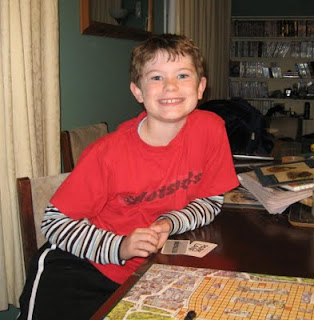 |
| Game Box |
Well it was another wet weekend again and so this week we decided on another 70's classic, Bermuda Triangle.
As there were only four of us for this afternoon it was a good opportunity to play this 2-4 player game.
Based on the mysterious area in the Atlantic Ocean where literally dozens of ships have disappeared over the years, you are the owner of a shipping line moving your vessels between ports around the board. Once you reach a destination you are rewarded with payment for the commodity you have just delivered.
 |
| Board Setup Ready to Go |
This payment varies per delivery although you always know what the next arriving ship will receive for their cargo. There are four ports and four commodities. The commodities vary in value, the most valuable being oil which to deliver you need to sail through the most dangerous part of the board, more details to follow! There is a bonus of $20,000 for each ship that gets to the home port on the board which is addition to commodity payment. The winner of the game is the first player to receive $350,000 in payments.
 |
| Cloud Spinner |
So this is a fairly simple roll and move game with a standard die, where you decide each move, which of your four ships you should move. Once a round after everyone has had a turn the Bermuda Triangle Mystery Cloud gets to move. This is achieved by a spinner deciding how much and in what direction the Cloud will move this round.
 |
| The Dreaded Cloud |
The Cloud is a large plastic vari-shaped object that sits, initially, in the centre of the board. Underneath and out of sight the cloud has two magnets attached to it which when moved over the board may (or may not) pick up a ship that unluckily gets in the cloud's way.
 |
| Yellow Ships THUNKED! |
Oh did I not mention, each ship has a strong magnet attached to the top of it?!!! So if the Cloud moves over or near any one of your ships during its move everyone at the table tends to go very quiet awaiting the dreaded THUNK of magnet upon magnet as the unlucky ship is out of the game!
 |
| Board Showing Ports and Ships (And Cloud!!) |
There is some strategy involved in the ship movements. If you land exactly on another ship you get to send this ship back to the previous port. Also you can block ports by deciding NOT to sail from that port and effectively forbidding entry by any approaching ship, including your own so be careful! Also as everyone can see the amount the next ship that docks at any of the ports will receive, you can therefore decide which ports to target first to receive the better reward.
 |
| Ships and Port |
So component wise the game does fairly well. Good quality plastic ships with magnets. Sturdy cards and simple instruction sheet. Typical quality for 70's board games and has fared well 35 years on.
Well onto the two games we played. The first was to $200,000 (short game), the second to $350,000 (full game). Game-play was straightforward although we had some discussions over exactly how quickly the Cloud should be turned or moved as well as where on the board EXACTLY some ships were before the Cloud moved. The Cloud can also pick up ships in ports, so port docking positioning also became important, oh how competitive some games can become, Michael!
Both games were fun but the second became slightly too long, although the fact that some ports were empty of rewards before the end of the game meant that tougher decisions were needed to decide which ship to move.
 |
| Guess Who Won??? |
 |
| Andrew's Winning Hand |
In the end Andrew triumphed, much to his delight he had beaten his father, and promptly exclaimed "that was the best game ever!" The rest of us thought it to be an okay game.
I would say overall a good light game for all the family, the short game better for excitement and closeness, and a game we will probably play again. Rules simple and the whole mystery Cloud eating ships mechanic seemed to amuse everyone except when it was one of their ships being disappeared(!)
The Good Points
- Easy to understand rules
- Nice colourful board with good quality components
- Although mostly luck, there is SOME strategy involved in each move
- FANTASTIC mystery Cloud with randomness of magnet
- Short game is fast and fun
- A fair bit of player interaction and commenting on the fate of each ship!
The Not So Good Points
- Not a huge amount of strategy involved, lots of luck
- Full game a bit too long
- Can be difficult to catch up if you are some way behind especially if being targeted by other players
- The bonus payment made no sense
 |
| Ready to Play Again? |
So votes from the Family
John 6/10
Joanne tba/10
Michael 7/10
Rachael tba/10
Andrew 10/10
Overall average 7.7
(Some votes still to come!)









